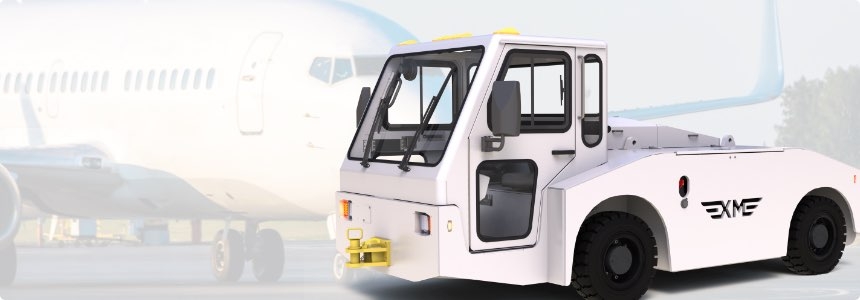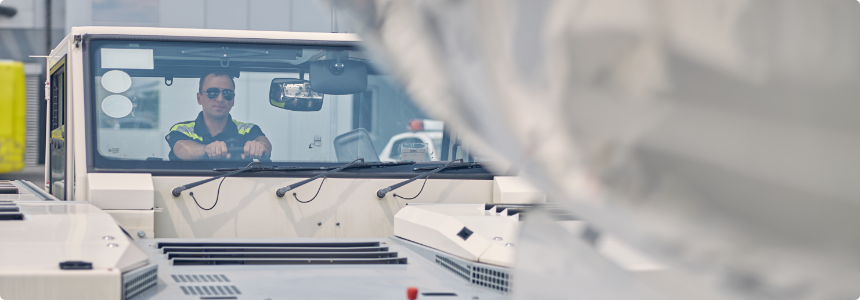Of course, no article can be an adequate substitute for proper training procedures in terms of understanding how to operate a tractor for airplane pushback and towing. Instead, this article will serve as a general overview of standard operating procedures, where we'll share some essential tips for aircraft tractor operations. Keep reading to find out more.
Check Your Aircraft Tractor Towbar Condition
An aircraft tractor towbar connects the tractor to the landing gear on an aircraft's nose. At the tractor-side attachment, the towbar can freely pivot laterally and vertically. These rotations can change the direction the aircraft's nose is pointing and thus change what direction the plane is moving.
After attaching the towbar to the plane, always ensure that it is correctly connected to the landing gear and the aircraft tug tractor before any movement is attempted. Additionally, you should always check that your towbar's shear pin is in place and that it isn't broken. The shear pin prevents the tractor and aircraft from damaging one another by snapping if the bar becomes overstressed. If your pin snaps, you'll have to disconnect the bar and reattach it to the nose gear in order to begin towing procedures again (with a new pin in place). After you have confirmed that your towbar is in good condition and secured to both the tug and aircraft, you can get moving.
Some aircraft tractors come in towbarless models, which removes the need for a towbar connection entirely. Towbarless tugs connect directly to the landing gear for more efficient towing and airplane pushback.
Look Before You Move
When learning how to operate a tractor, proper training will stress the necessity of looking before moving. Aircraft tractor operators who perform airplane pushback and towing procedures act directly as the pilot's eyes – during transport, the pilot cannot see anything behind the aircraft. As such, operators need to have keen spatial awareness as they move the aircraft. When performing any kind of airplane pushback or towing, look in the direction you intend to move before you start. You need to take time to ensure you will have proper clearance during all parts of your route and that you will not interfere with anyone else's movements.
As you operate your aircraft tug tractor, you must also communicate with both the pilot (or another qualified brake rider in the cockpit) and the air traffic controllers. These individuals will help determine where you can and cannot move the aircraft. They will keep you updated on the positions of other operators, which are just as subject to change as the arrival and departure times of airplanes due to factors such as last-minute maintenance, pilot switching and weather.
In short, always be attuned to your surroundings when operating an aircraft tractor as you would driving your car on a busy highway.
Think Slow & Steady
When operating a pushback tractor, always set a steady speed and try your best to stick to it. This will help keep your senses sharp when looking for potential obstructions in your route, giving you ample time to process how much space you have going forward (or backward).
Maintaining a slower speed is also crucial when traction might be compromised. A fuel-soaked flight deck or wet, icy concrete can hinder your maneuverability and interrupt airplane pushback or towing operations. Remember, other operators will be having a similarly difficult time in such conditions – going slow will allow you to keep an eye on your fellow drivers and ensure there are no traffic jams on the tarmac.
Always Shift to the Proper Gear
It may seem obvious, but when learning how to operate a tractor, you'll want to always keep it in the appropriate gear to minimize any strain on the engine. The goal is to prevent excessive wear on the aircraft tug tractor as a whole to ensure it lasts as long as possible.
A tip for shifting gears in a pushback tractor: Always shift into a lower gear if your engine speed drops by 10 percent. Keep a close eye on your speed fluctuations to help prevent any breakdowns.
Avoid Sharp Turns in an Aircraft Tractor
Earlier, we mentioned the shear pin you'll find on your aircraft tractor towbar. This is used to prevent damage to both your aircraft tug tractor and the landing gear, but it can't stop everything. If you take too sharp of turns, the towbar may hit the back of the airplane tractor and cause a severe amount of internal and external damage. It's best to keep in mind that the aircraft has to follow when you make a sharp turn. If it seems like you may not have enough clearance to make a particular turn or other aircraft tractors might get in the way, you may want to readjust your positioning.
Also, you should always consider how familiar you are with the pushback tractor you're operating. Not all aircraft tug tractors have the same dimensions and turn radius – the things that determine the maneuverability of the tractor. If you attempt a turn your tractor isn't capable of making, you'll cause damage to both the tractor and the aircraft.
Become an Aircraft Tractor Operator with the Help of Eagle Tugs
The flightline is a fast-paced and loud environment – it's just the nature of the job. With a flurry of activity happening around every corner to ensure flights are taking off and landing as scheduled, learning how to operate an aircraft tractor or how to pushback an aircraft properly can be quite a challenge. Luckily, Eagle Tugs offers aspiring aircraft tug tractor operators extensive commissioning, maintenance and operation training. To learn more, request a custom class or contact us today.
Request a Custom ClassRelated Articles
 AIRCRAFT TOWING PROCEDURES Runway towing is a very precise operation and one that can be hazardous if you aren't following the proper taxiing procedures. There are many moving parts...
AIRCRAFT TOWING PROCEDURES Runway towing is a very precise operation and one that can be hazardous if you aren't following the proper taxiing procedures. There are many moving parts... PREVENTIVE MAINTENANCE PROCEDURES FOR AIRPLANE TUGS Regular maintenance and repairs are necessary for airplane tugs in order to avoid costly damage and downtime — this includes preventive maintenance...
PREVENTIVE MAINTENANCE PROCEDURES FOR AIRPLANE TUGS Regular maintenance and repairs are necessary for airplane tugs in order to avoid costly damage and downtime — this includes preventive maintenance... TYPES OF AIRPLANE TUGS, FROM SMALL AIRCRAFT TUGS TO ELECTRIC TOWBARLESS TRACTORS An airplane tug is used to prepare an aircraft for take-off or transport a craft for regular maintenance and repair. It's a crucial component of any airport or hangar's ground support equipment (GSE)...
TYPES OF AIRPLANE TUGS, FROM SMALL AIRCRAFT TUGS TO ELECTRIC TOWBARLESS TRACTORS An airplane tug is used to prepare an aircraft for take-off or transport a craft for regular maintenance and repair. It's a crucial component of any airport or hangar's ground support equipment (GSE)...


